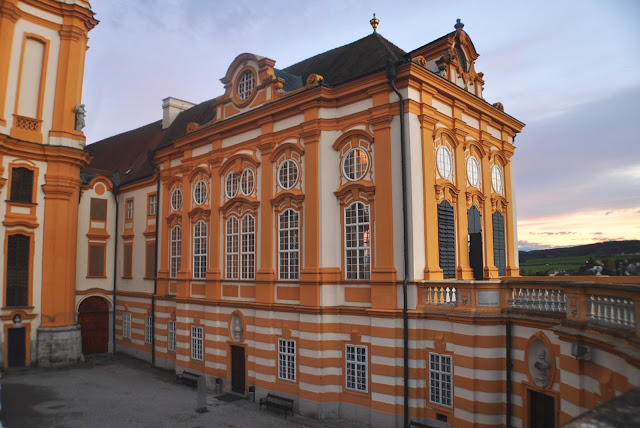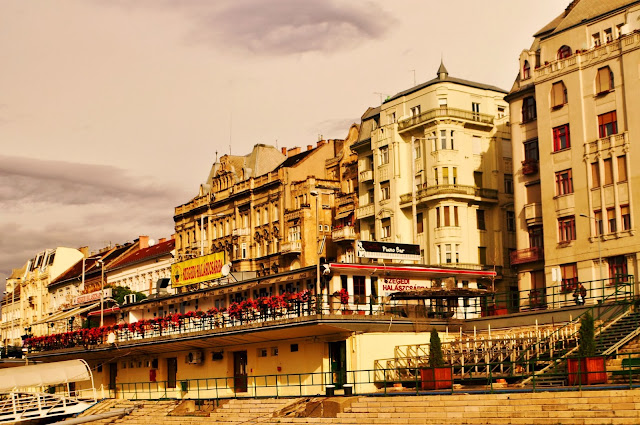Today was the first day that it was raining when I woke up, can't really complain since it has been in the 60's since the beginning of my trip with mostly sunny skies. We we scheduled to arrive in Passau only at 9:00am which meant I could sleep in a bit and have a later breakfast.
Passau is a town in Lower Bavaria, Germany. It is also known as the Dreiflüssestadt or "City of Three Rivers," because the Danube is joined at Passau by the Inn river from the south and the Ilz from the north.
Passau was an ancient Roman colony of ancient Noricum called Batavis, Latin for "for the Batavi." The Batavi were an ancient Germanic tribe often mentioned by classical authors, and they were regularly associated with the Suebian marauders, the Heruli. During the second half of the 5th century, St. Severinus established a monastery here. In 739, an English monk called Boniface founded the diocese of Passau and this was the largest diocese of the Holy Roman Empire for many years.
During the Renaissance and early modern period, Passau was one of the most prolific centres of sword and bladed weapons manufacturing in Germany (after Solingen). Passau smiths stamped their blades with the Passau wolf, usually a rather simplified rendering of the wolf on the city's coat-of-arms. Superstitious warriors believed that the Passau wolf conferred invulnerability on the blade's bearer, and thus Passau swords acquired a great premium. As a result, the whole practice of placing magical charms on swords to protect the wearers came to be known for a time as "Passau art."
Passau was secularised and divided between Bavaria and Salzburg in 1803. The portion belonging to Salzburg became part of Bavaria in 1805. From 1892 until 1894, Adolf Hitler and his family lived in Passau. The city archives mention Hitler being in Passau on four different occasions in the 1920s for speeches. On November 3, 1902 Heinrich Himmler and his family arrived from Munich. They lived at Theresienstraße 394 (currently Theresienstraße 22) until September 2, 1904. Himmler maintained contact with locals until May 1945.
During World War II, the town housed three sub-camps of the infamous Mauthausen-Gusen concentration camp: Passau I (Oberilzmühle), Passau II (Waldwerke Passau-Ilzstadt) and Passau III (Jandelsbrunn).
Tourism in Passau focuses mainly on the three rivers, the St. Stephen's Cathedral and the "Old City" (Die Altstadt). With 17,774 pipes and 233 registers, the organ at St. Stephen's was long held to be the largest church pipe organ in the world and is today second in size only to the organ at First Congregational Church, Los Angeles, which was expanded in 1994. Organ concerts are held daily between May and September. St.Stephen's is a true masterpiece of Italian Baroque, built by Italian architect Carlo Lurago and decorated in part by Carpoforo Tencalla. Many river cruises down the Danube start at Passau and there is a cycling path all the way down to Vienna. It is also notable for its gothic and baroque architecture. The town is dominated by the Veste Oberhaus and the former fortress of the Bishop, on the mountain crest between the Danube and the Ilz rivers. Right beside the town hall is the Scharfrichterhaus, an important jazz and cabaret stage on which political cabaret is performed.
On the walking tour we visited the cathedral and had an organ recital which was very enjoyable. These European cathedrals are so detailed in their ornamentation. Baroque and gold leaf is everywhere making the experience surreal.
The rain started to increase and the cobbled-stoned streets were getting really hard to walk on and I was finding it difficult to hold an umbrella in one hand and a camera in the other without getting it wet. I was starting to get impatient and ready to turn around and go back to the ship on my own when lo and behold as we came close to the Inn river I came across an old lady feeding some ducks. There were dozens of these feathered creatures everywhere around her. They are not fearful of people so it was easy to approach them. Considering my affection for ducks I was thrilled at this encounter which totally gave me my second wind. Then some swans came by to make this a perfect scene, I just had to take a ton of shots of them.
This was the last day of my trip and I thought it was fitting to end it the way I began it two weeks ago by looking at the little ducks I love so much.
We went back to the ship and as I was packing it was great fun to think of all the magical towns and places I had visited. It definitely is true that life is like a book and if you don't travel you have only read a page. I have been fortunate to have added many new pages to my book and will look forward to the next.






















































